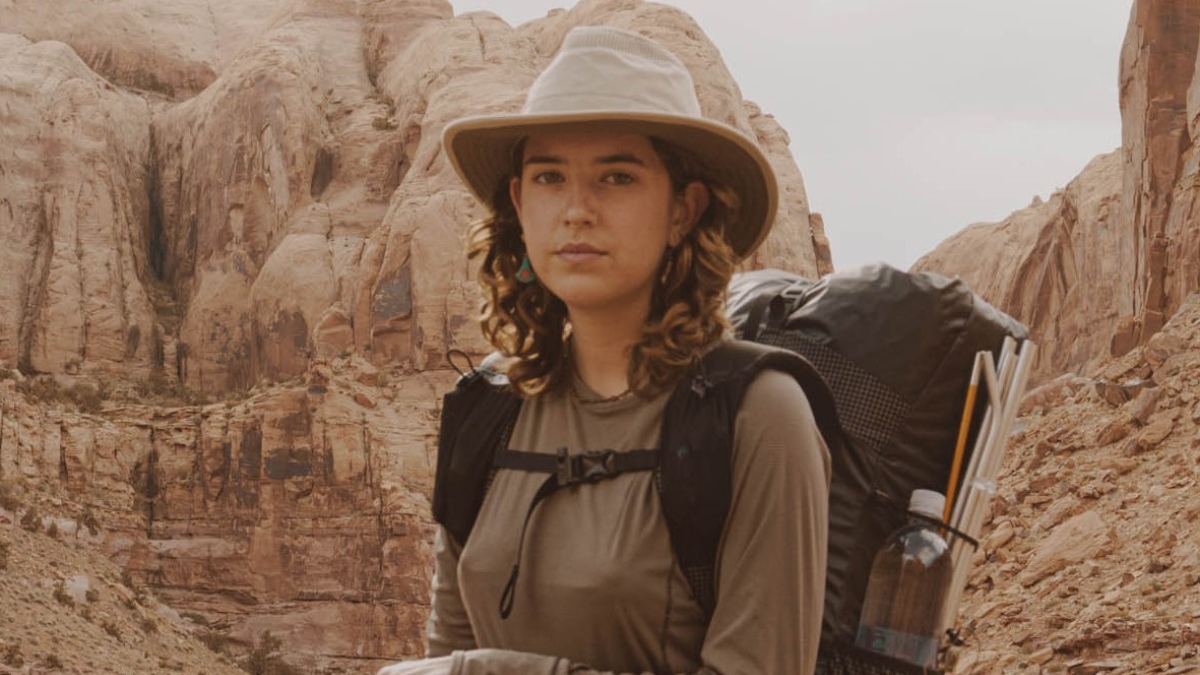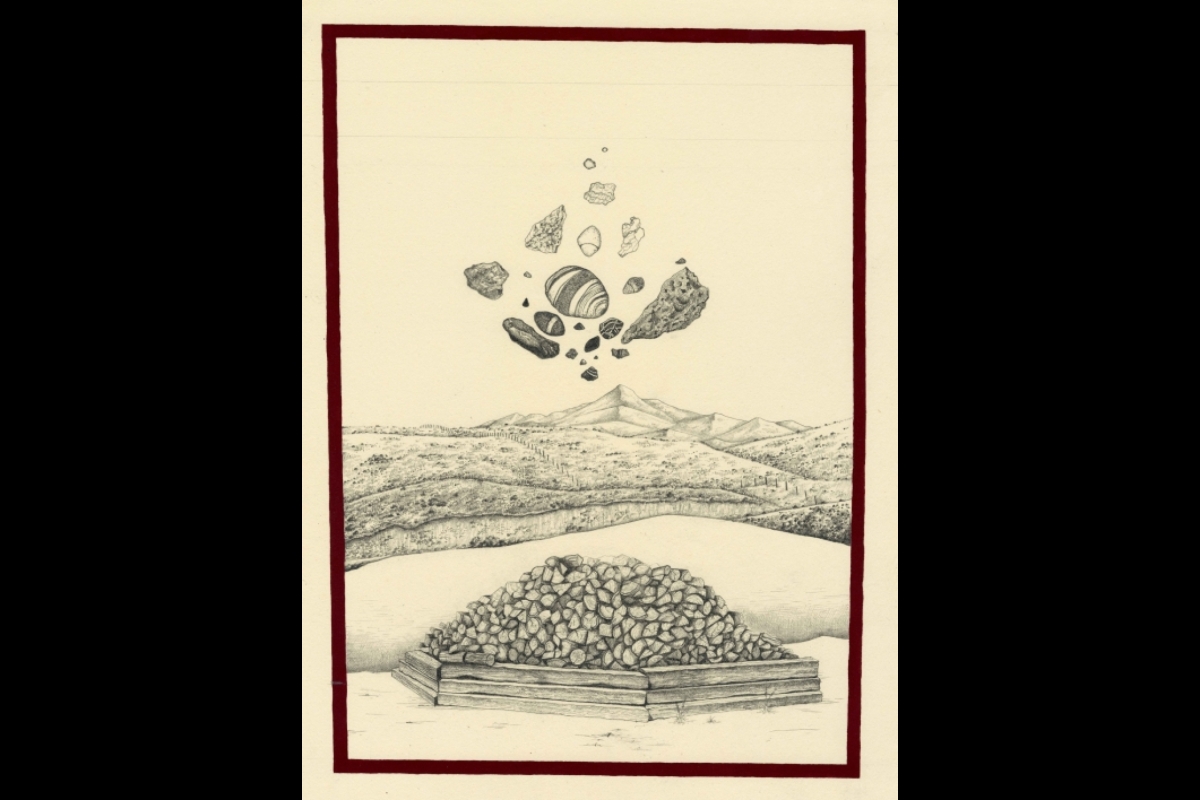Graduating art student finds inspiration in American Southwest

Rachel Hebert
Editor's note: This story is part of a series of profiles of notable fall 2020 graduates.
During her time at Arizona State University, Rachel Hebert walked 500 miles across Colorado, climbed a 1,200 foot wall in Zion National Park and summited numerous 14,000 foot peaks.
“I have spent much of my time here exploring the public lands that make this country great and seeking to convey their beauty in the gallery space,” said Hebert, who graduates this December with a BFA in printmaking.
“I grew up nestled at the base of the Wasatch Mountains and my childhood was spent mostly alone,” she said, “exploring the endless woods behind my house in search of natural treasures. In my teenage years, I embarked on a series of solo road trips through the Four Corners Area. These early experiences in the desert formed a deep love for the arid region, so I moved to Arizona in 2018 to pursue my printmaking degree at ASU.”
Hebert, who goes by K or KOSA, said her creative process is just as involved outside the studio as it is on campus.
“My process begins, first and foremost, in the wilderness,” she said. “I spend long months in the backcountry, exploring vast landscapes and ecosystems, photographing, drawing, and writing about them. I study the landscapes I explore in slow, solitary detail while crawling through desert canyons and climbing alpine peaks. I take great care to observe the cycles of the seasons, life and death, cause and effect.”
Herbert said her recent body of work, Westward, praises the landscapes that have shaped the past two years of her life.
“I’ve been deeply enamored by the secrets buried beneath the vast deserts of the American Southwest,” she said. “I’ve explored landscapes split apart, eaten by canyons, pushed up through colliding plates and buckling crust, and eroded away slowly by wind and water. Through the process of etching limestone and copper, mixing paint and blending graphite, I seek to imitate the wind scraping those sandstone cliffs. I emphasize the smallest details to draw attention to the most delicate aspects of our environment. This is the only way I know how to uncover the deep mysteries of the West: to take it into myself and become it. I believe that only through deeply understanding the wildest and most remote areas of our planet can we begin to prioritize their preservation.”
In addition to the natural surroundings that inspired her art, Hebert is also grateful for the financial support she received while at ASU that allowed her to fully pursue her education and her art.
She received numerous scholarships, including the New American University President’s Award, the Special Talent Award, the Herberger Scholarship, the Windgate Foundation Scholarship, the Del Decil Scholarship in the Visual Arts, the ASU Sun Angel Award, the Eirene Peggy Lam Award, and the J.R. and B Nelson Scholarship.
“Receiving these scholarships reassured me that I was on the right path,” she said. “They gave me the opportunity to focus on my studies and grow into the artist I am becoming.”
View more of her work at kosa-art.com.
Question: What was your “aha” moment, when you realized you wanted to study the field you majored in?
Answer: I was first introduced to printmaking as a medium through a studio art class I took at Weber State. I carved my first relief block in the spring of 2017 and decided to take a printmaking class the next semester. When I etched my first copper plate that next fall, a light was sparked inside of me; etching felt as intuitive to me as walking or breathing. My professor, Kay Stevenson, recognized my innate love for the process and encouraged me to further my printmaking education. I certainly didn’t choose the most traditional career path but I think sometimes when the universe shouts at you, you have to listen.
Q: What’s something you learned while at ASU — in the classroom or otherwise — that surprised you or changed your perspective?
A: I had the incredible opportunity to be the artist-in-residence at a permaculture farm in Montana this summer. The hosts of the residency were two lovely individuals who have spent their careers studying and living in harmony with the natural world. Their homestead in the golden hills of rural Montana showed me how simple it is to be a steward of the planet and that art is a powerful tool for change. My experience there completely changed the way I look at my own impact on the environment and expanded my preconceived ideas of what sustainability looks like.
Q: Why did you choose ASU?
A: I chose ASU because it has one of the best printmaking programs in the country. I was also drawn to the location of the campus because my work is deeply rooted in the landscapes of the American West and I felt particularly fond of the geology and ecology of the desert Southwest.
Q: Which professor taught you the most important lesson while at ASU?
A: It’s hard for me to choose one professor who influenced me the most. Mary Hood and Melissa Button both played pivotal roles in my growth as an artist. Melissa taught me the value of hard work and demonstrated the importance of supporting your peers. Mary Hood taught me to follow my intuition and to believe that I was capable of achieving any goal. Both professors always understood my need to immerse myself in the wilderness and were patient with me whenever I was difficult to contact. I don’t think I would’ve finished this degree without their support.
Q: What’s the best piece of advice you’d give to those still in school?
A: Education is an absolute privilege. Your thirst for knowledge shouldn’t end with your degree. Gratitude often overtakes stress. Take a walk.
Q: What was your favorite spot on campus, whether for studying, meeting friends or just thinking about life?
A: I spent most of my time on campus in the intaglio studio. Every evening around sunset I would sit on a stool on the east balcony of the fourth floor of the art building. The Four Peaks of the Mazatzal Mountains rise just above the campus skyline and every sunset I saw from that viewpoint was breathtaking.
Q: What are your plans after graduation?
A: Due to the current state of the world, my plans after graduation have shifted so many times over the past couple months and will probably continue to. I am applying for an internship at Mullowney Printing Company in Portland, Oregon. If that internship falls through, I plan to complete a long awaited goal of walking from Mexico to Canada along the Continental Divide Trail. I also plan to apply for some more artist residencies that focus on the relationship between art and the environment. Ultimately, I plan to attend graduate school in the fall of 2022 to pursue my MFA in art and ecology.
Q: If someone gave you $40 million to solve one problem on our planet, what would you tackle?
A: I would use the money to fund climate change initiatives and research. The climate crisis is one of the biggest catastrophes of my generation, and I worry everyday about the future of our planet. I strongly believe that environmental rights are human rights and that protecting our environment is the first step towards healing the wounds in our society.
More Arts, humanities and education

The Design School wins award for impactful design education
Luis Angarita, program head for The Design School’s industrial design program, attended the inaugural Don Norman Design…

ASU professor’s award-winning book allows her to launch scholarship for children of female shrimp traders in Mexico
When Arizona State University Associate Professor Maria Cruz-Torres set out to conduct the fieldwork for her third book, "Pink…

Herberger Institute Professor Liz Lerman to be honored as Dance Magazine Award winner
Dance Magazine has announced that Arizona State University Herberger Institute Professor Liz Lerman will be honored as a…


